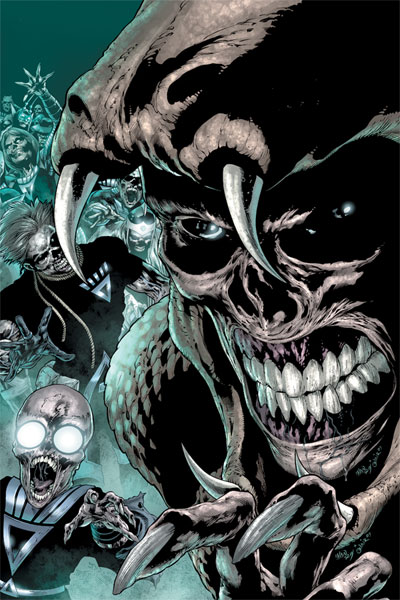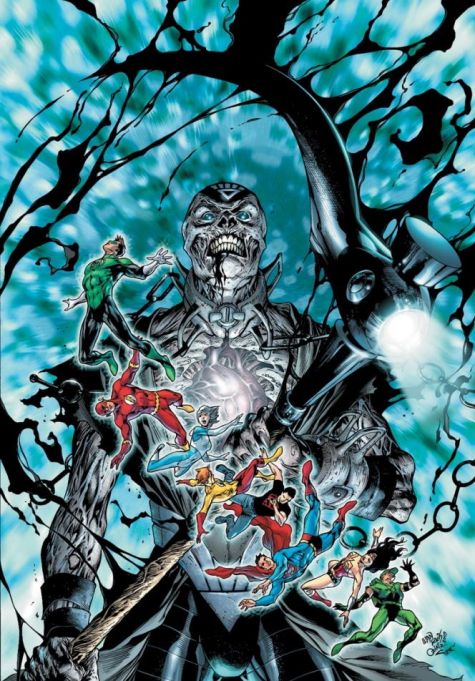- Comics
- Comics Reviews
- Manga
- Comics Reviews
- European Comics
- News
- Comics News
- Press Releases
- Columns
- Spotlight
- Digital Comics
- Webcomics
- Cult Favorite
- Back Issues
- Webcomics
- Movies
- Toys
- Store
- More
- About
By Andy Frisk
November 6, 2009 - 23:37
Black Lanterns continue to overwhelm the universe, and the Earth in particular. Barry Allen/The Flash, Mera, and Ray Palmer/The Atom attempt to rally Earth’s forces in order to keep the Black Lanterns at bay while Hal Jordan and “The Lite Brite Brigade” (the spectrum colored power ring Corps), as Barry calls them, attempt to shut off the source of the Black Lanterns’ power. What happens though when that very source of power arrives on Earth?
 |
Blackest Night #4 delivers more of the hideous Black Lanterns that have been playing havoc with the emotions of the heroes they’re tied to. As Barry states, while they are not the true souls of their departed loved ones reborn, they nevertheless have an incredible effect on the living’s emotions. Barry manages to effectively spread the word on how to combat these Black Lantern horrors, but when he ends up face to face with a new threat named Nekron, with the Black Lantern Power Battery literally behind him, he will have to find a new wellspring of strength inside him to make a stand.
Blackest Night grinds on with this relatively well paced and interesting installment, but it doesn’t live up to the power of the previous issue in the series. The arrival of Nekron at the end of this issue, coupled with the arrival of the Black Lantern Power Battery on Earth, in a very specific and prolific location, does definitely set the reader up for an eye popping and action packed ride next issue (hopefully), but getting there is a bit of a drag. It seems that every single hero in the DC Universe, however obscure, has to personally confront a personally attached Black Lantern who has been commanded to RISE to specifically torment him or her. For many readers, especially those who are relatively new to the DC Universe or haven’t read a wide range of titles from DC Comics’ superhero line over the years can get lost in the storyline. They might not know every hero’s emotional back story ties to their own personal Black Lanterns. For the well read DC Universe reader, the exact opposite can be the case. They may get lost in hours of reminiscing over past storylines. A mega-event like Blackest Night is intended to draw in new readers and hopefully encourage them to pick up other books in the publisher’s line. Blackest Night can definitely do this, but it can also turn some readers away. This is the case simply because there is an overwhelming amount of previous events and storylines that could not possibly be caught up on in time to enjoy all of Blackest Night’s most obscure references as the series unfolds.
 |
The allegorical meaning of Blackest Night is a tale that everyone can relate to quite easily, even without a complete knowledge of each hero’s back story. This overcomes the shortcomings of the tale’s repetition of events (hero faces Black Lantern version of deceased loved one, colleague, or friend, gets upset, either overcomes the Black Lantern or dies-wash, rinse, and repeat with new hero). As The Black Hand states at the beginning of issue #4, “‘Let there be light’ sparked the beginning of the war. Our Blackest Night will end it.” The tale has taken on a quasi-religious meaning. All religious questions and conflicts (and most moral ones, for that matter) boil down to a simple dichotomy of light vs. dark, which is allegorically understood as good vs. evil. Servants of the evil are often referred to as demonic, and what is more demonic than a risen and defiled, twisted and perverted version of one’s fallen loved ones? The fact that each hero is facing a personal Black Lantern, specific to their emotional losses of the past, is allegorical of the task of facing ones’ personal demons. In reality, the heroes aren’t facing loved ones who’ve returned to torment them. They are facing a manifestation of their own personal feelings of regret, loss, or failure which is personified in the form of a zombie-like, hideously reanimated, fallen loved one. All of this is quite obvious, and the point is not to belabor the obvious, but to pause and put into words the depth of thought and meaning that Johns is putting into the third major act of his epic run on Green Lantern. From Green Lantern Rebirth through The Sinestro Corps War, and now into Blackest Night, Johns has really been taking us on a thoughtful, insightful, and powerful ride.
Reis and company continue to bring us some great, twisted, and frightening looking Black Lanterns. The Black Lanterns’ rotting flesh and costumes, which serve as corrupted versions of the fallen heroes’ outfits, are quite creative, and are a treat to examine. The incredible amount of death in the series is relayed horrifically enough to jar the reader, but restrained enough to keep the reader from losing his or her lunch as they read. The ripping of the heroes’ living hearts from their chests is graphic, but not a gory glorification of grossness.
Blackest Night is still a great read. After getting some answers last issue, the series was really poised to take off, and it’s still in liftoff stage. Now that a major player behind the scenes has been revealed, the series should continue to soar even higher.
Rating: 8.5 /10